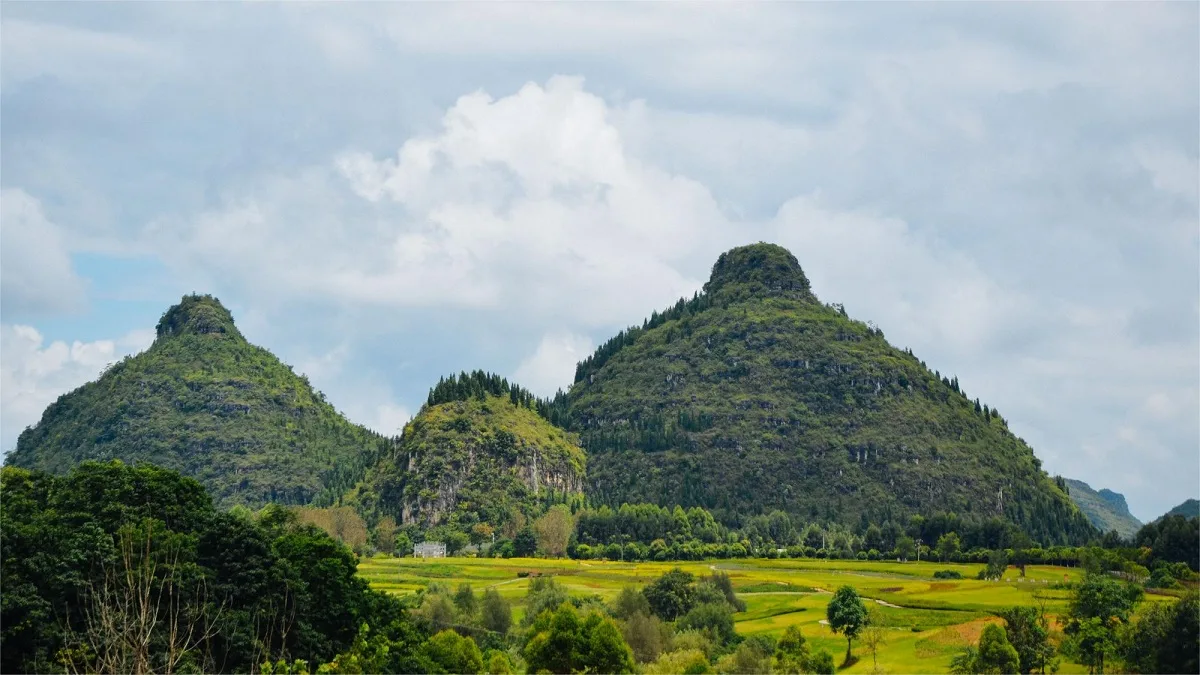Shuangru Mountain (双乳峰), also known as Double Breast Peaks, is located in Zhenfeng County, Guizhou Province. Covering an area of 2100 acres, the peak reaches an altitude of 1266 meters, with a relative height of 262 meters. Its name is derived from its striking resemblance to the exposed breasts of a mother earth figure. Viewed from various angles, the peaks exhibit shapes resembling breasts at different stages of aging. From the observation platform, they appear as the breasts of a woman in her twenties, while viewed from a 500-meter angle, they resemble the breasts of a woman in her forties. Another angle at 500 meters presents the image of breasts of a woman in her sixties. This natural wonder showcases the incredible artistry of nature.
Local people, particularly the Buyi ethnic group, worship Shuangru Mountain as the “Mother Earth” and “Source of Life.” Some devout individuals even come to the mountain to pray and prostrate themselves in hopes of fertility, wealth, or peace, considering it a sacred site of spiritual significance.
Table of Contents
Basic Information
| Estimated Length of Tour | 2 hours |
| Ticket Price | Admission: 80 RMB Shuttle Bus: 30 RMB |
| Opening Hours | 8.30 – 17.30 |
| Telephone Number | 0086-0859-6611999 0086-0859-6775586 |
Location and Transportation
Shuangru Mountain is located at the border between Minguzhen Town and Zhexiang Town in Zhenfeng County, Qianxinan Buyei and Miao Autonomous Prefecture, Guizhou Province, near Beipanjiang Grand Canyon. To get there:
- From Guiyang: Take a bus to Zhenfeng, which passes by Shuangru Mountain. Inform the bus driver that you want to get off at Shuangru Mountain Station.
- From Xingyi: Take a bus to Zhenfeng Bus Station, then transfer to a bus heading to Niuchang, which also passes by Shuangru Mountain.
Highlights of Shuangru Mountain
Zhulinbao Stone Forest

Zhulinbao Stone Forest in Shuangru Mountain Scenic Area is a typical karst landform, characterized by its small and exquisite appearance and unique charm. It is one of the eight major stone forest landscapes in Guizhou Province. The rocks here have complex compositions and varying thicknesses of layers. Through the processes of dissolution and erosion, a variety of peculiar-shaped rocks have been left behind, representing the late stages of landform development. Each stone in the park tells a different story, from the welcoming stone resembling a natural ornamental column at the entrance to ancient fossilized skulls, stones resembling the head of Zhu Bajie (a character from Chinese mythology), a general going to battle in armor, and arrows shooting into the sky, sparking endless imagination and leaving a lasting impression.
Festivals and Performances

The Buyi ethnic group in Zhenfeng County celebrates various traditional festivals throughout the year, with notable ones such as the “Third Month Third” and “Sixth Month Sixth” festivals. Among these, the “Sixth Month Sixth” Song Festival is the most grand and significant in Zhenfeng. Every day at 11 AM and 3 PM, there are performances of the “Eight-Sound Seated Singing,” which was recognized as a national intangible cultural heritage in 2005. Visitors can immerse themselves in the melodious tunes of this traditional Buyi music, experiencing the pure and enchanting sounds of the Buyi ethnic group.
Zhenguan Temple

Situated next to the Zhulinbao Stone Forest, Zhenguan Temple overlooks the Double Breast Peaks. Originally built as the Zhenfeng Guanyin Temple during the Guangxu reign of the Qing Dynasty, it was later restored and renamed Zhenguan Temple. Covering an area of 50 acres with a total investment of 30 million yuan, the temple features halls such as the Heavenly King Hall, the Great Hall of the Great Heroes, the Guanyin Pavilion, and vegetarian dining halls. Inside the temple, visitors can find golden statues of Shakyamuni Buddha, Maitreya Buddha, and Avalokitesvara Bodhisattva, making it a sacred Buddhist site in Southwest China.


